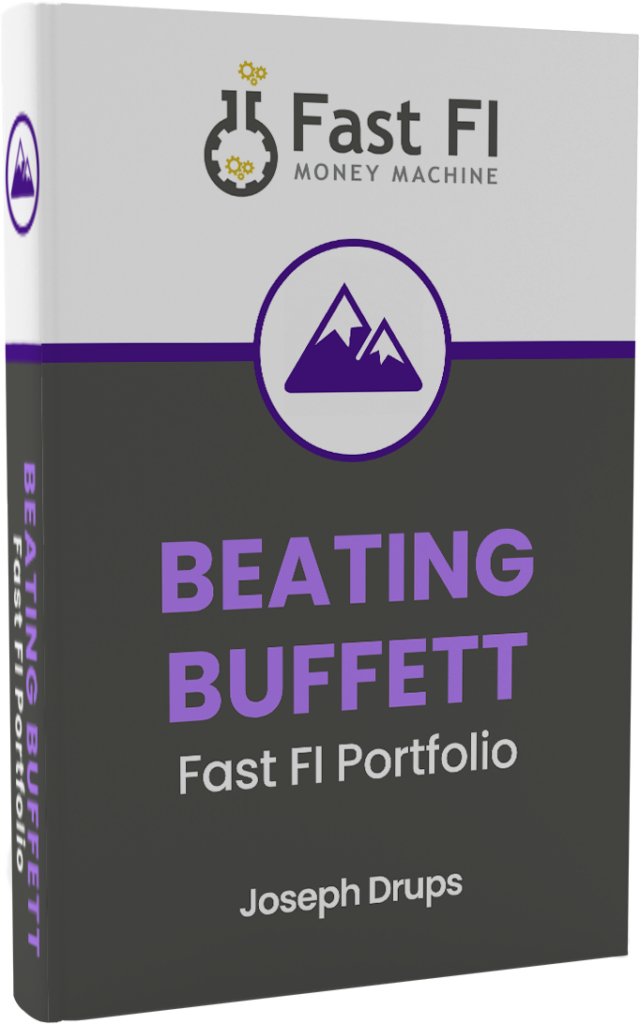Fast FI: Achieve Financial Freedom in 5 Years or Less
In this article, I’ll walk you through part three of a three part ultimate guide to financial freedom.
I plan to discuss Fast FI (Fast Financial Independence). This is the third path to financial freedom and it focuses on growing your income and turning it passive fast, which means under 5 years to FI.
In my previous articles, I discussed the concepts of 1) Frugal FI and 2) The Way of Wealth. These two paradigms both lead to financial freedom through different paths.
In Article 1 of our Catching FIRE series, The Ultimate Guide to Financial Freedom – Frugal FI, I discuss the path to financial freedom based on adopting a mindset of financial freedom founded on happiness and personal growth, not stuff. By focusing on growing your skillset and cutting costs you can reduce your costs significantly, while keeping your income steady.
This allows you to drive up your savings rate and lower the bar to achieve financial independence at an accelerated rate. This path isn’t for everyone, but the important take away is that a key variable in your speed to financial freedom is your savings rate, or the spread between your income and expenses.
Article 2 of this series, The Way of Wealth, takes the opposite tack and adopts a mindset of growth and abundance. Although cutting costs has a limit, growing your wealth does not. You are capable of creating a near infinite amount of value in the world.
By creating value for other people that they’re willing to pay for, you grow wealth. If you’re willing to learn how to hustle, develop good money habits, increase your knowledge to grow income, and ultimately invest for passive cash flow then you can achieve truly astounding levels of wealth in all areas of your life.
Ultimately, this path leads to financial freedom and leaving a legacy for future generations. By focusing on growing your income, not only cutting expenses, you can utilize the 10 Principles of Abundance to move through the 6 Stages of Wealth and make your dent on the world.
Those short summaries outline the two different paths we covered in part 1 and part 2 of this series.
- Click here to read the Catching FIRE pt 1: Ultimate Guide to Financial Freedom – Frugal FI.
- Click here to read the Catching FIRE pt 2: Ultimate Guide to Financial Freedom – Way of Wealth.
This article will take parts of the Way of Wealth, Frugal FI and our Fast FI methodology of high return investing to show you how to significantly increase your rate of wealth accumulation and achieve financial freedom in 5 years or less.
Strap yourselves in because we’re about to cut your time to retire in half.
Buying Financial Freedom
The goal of this article is to show you how you can mix and match the Frugal FI, Way to Wealth, and Fast FI strategies to accelerate your path to financial independence.
To achieve this, let’s build out a few different scenarios to early retirement and examine the strategies that beat a 5 year retirement goal. This let’s you understand the range of options that are available for you to achieve Fast FI (Fast Financial Freedom).
Savings Rate + Income + Investment Return = Length to Retirement
The simple path to retire early is to focus on three things: 1) Increase your return. 2) Increase your income. 3) Increase your savings rate (aka cutting costs).
However, even with an average income if you’re able to achieve a high return on your money mixed with a Frugal FI lifestyle you can achieve financial freedom early in life.
The average income for a college graduate is currently: $55,260. Let’s use those numbers and start from $0 net worth to run through different scenarios in order to beat a 5 year early retirement plan.
A resource to help run your own numbers is this Years to Retire Calculator by networthify.com: Years to Retire Calculator.
Average Joe’s Path to Financial Freedom
First, as a benchmark, let’s take the average Joe’s financial freedom journey.
For Average Joe, I’ll use all the averages from the U.S. census data: 1) Average income of a college graduate. 2) The average annual raise. 3) The average savings rate. 4) The average return of index fund investing over the last 5 years. 5) The average 1.94 children. You get the idea.
Specifically, I’m going to use the cross-over point when Average Joe’s income from investing exceeds his expenses. You should calculate a conservative estimate for yourself. The classic 4% rule estimates a withdrawal rate of 4% of your total net worth assuming a conservative 6% return on your money.
However, when you earn a higher-than-average return on your money, simply deduct 2% from your average passive return to get a more conservative number.
The result of this dismal approach of the average American is 37 years to retire. That means the average college graduate would graduate at around 58 years old.
Eck.
We can blow that out of the water.
Below I summarize Average Joe’s path to retirement (aka financial freedom) versus other financial decisions he could have made with the same income.
Figure 1: Four Paths for Average Joe
For fun, I took Mr Money Mustache (famous FIRE blogger) and pitted his journey to financial freedom up against the other paths I discuss in this article. I used his average expenses as a cap for our FIRE examples so I could put them on the same scale.
Since Average Joe is modeled after the average American with a college degree, I didn’t cap his spending because the average American doesn’t cap their spending as their income rises.
Frugal FI Joe: Average Earner
Frugal FI Joe takes the same averages as Average Joe, but models a dedicated saver. That means he pinches every penny and sets a $35,000/yr expense cap on his lifestyle expenses. Everything above that goes to savings and investing. This is similar to what Mr. Money Mustache and other Frugal FI practitioners have been able to accomplish.
The cap on spending and a Frugal FI paradigm allows them to massively increase their savings rate and shorten their time to retirement.
Frugal FI Joe begins with just above a stellar 30% savings rate, and this increases as his income increases because he avoids the creep of increasing lifestyle expenses as income grows by capping his expenses. He’s following the Frugal FI path to wealth.
Our Frugal FI persepctive was the first article in our Catching FIRE series which you can find here.
High Returns: Fast FI Joe & Real Estate Joe
The other two options I included in the above table were the estimated return our average income Joe can get from either real estate or small business investing.
The biggest difference here is the return the investor makes on the different types of investing.
Fast FI Joe earns 32% from passive small business investing based on our Fast FI philosophy, and Real Estate Joe earns 20% based on the BRRR method of real estate investing (Buy, Renovate, Refinance, Rent).
With small business investing his investments pay for his lifestyle and early retirement 2 years earlier than with real estate investing (see Figure 2 below).
However, over the long-term as the money compounds these differences grow much larger.
Figure 2: Net Worth Comparison for Average Joe’s Investing Strategies
Compounding the 4 different versions of Average Joe’s net worth gets you stark differences. By year 10, Fast FI Joe is more than double the net worth of real estate investing Joe. By year 20 (41 years old), he’s at 5x the wealth.
On top of that, Real Estate Joe is using a method that requires upfront renovation (Buy, Renovate, Refinance, Rent), so it’s not a fully passive concept. You would have to drop down to about 12%-15% ROI for a fully passive real estate syndication concept in the private markets which puts Real Estate Joe further behind.
Compare that to Fast FI Joe’s small business investing concept which is setup inside an investing club to manage a passive portfolio of cash flowing small businesses.
Fully passive. High return. Fast Financial Freedom. Early Retirement.
In case you were wondering, that’s why we’ve developed the Fast FI methodology.
At the writing of this article, I just closed on my 7th business, so I have some experience in small business investing. I’ve also co-owned a house flipping business as well and I invest regularly in real estate so I pull what I believe to be realistic numbers from personal experience in projects I’ve reviewed or invested in.
Fast FI Joe’s path to financial freedom will be based on the core investing strategy that led to my own success which was through cash flowing, small business investing. I cover this methodology in my article, 32% Return: The Investment Strategy that Beats Billionaires and the companion resource, Beating Buffett – Portfolio Guide.
This is the genesis of the Fast FI methodology that allows small investors (under $10 Million in investable net worth) to beat Warren Buffett’s investing return while buying down risk by working within an investing club with an Overwatch entity.
Small business investing is the core premise of our Fast FI investing club, so feel free to Click Here to learn more.
This first set of scenarios used the average college graduate’s salary. Next let’s see how, the investing case improves when you take high income earning professionals.
Wealthy Wesley
Wealthy Wesley is the name I’ll use for our high income earner example. Let’s run through a few paths to wealth for high income earners.
With this path to wealth, we’ll loosen up the Frugal FI mentality and put our spending cap at $60,000 which offers a comfortable middle class lifestyle.
Figure 3: Five Paths for Wealthy Wesley
Across the board, the high income earner has the option to retire earlier then Average Joe. Ok, that’s not a surprise.
All it takes is a high income, a frugal perspective and even with the low returns of index fund investing Wealthy Wesley can retire at age 35 with no cap on expenses and a 30% savings rate. That’s not half bad.
Add a comfortable middle class $60,000 cap and a high return by investing in real estate or small businesses and Wealthy Wesley can retire in a ridiculous 3-4 years as early as 25 years old while living a comfortable lifestyle.
Layer on top of that a Frugal FI $35,000 expense cap and a Fast FI investing return, and a high income earner can retire in one year.
Feeling a little envious?
Some or all of these scenarios might seem unreachable, but it’s helpful for the sake of our discussion to understand what’s possible at the extremes.
Wealthy Wesley and Hedonic Adjustment
There is one concept I want to touch on before calculating Wesley’s net worth with different strategies.
That is the peculiar instance of Hedonic Adjustment.
Hedonic Adjustment is the technical term called by many other names. This is that desire to “keep up with the Jones.” Since we live in a consumer culture, the default is a low savings rate and high consumption rate. That means high income earners with a low savings rate have an incredible amount of money to spend.
Notice how Wealthy Wesley who’s following a hedonic adjustment path is: 1) Earning an extremely high salary, and 2) Achieving an incredible level of return. Yet, he’s still a wage slave who can never retire due to his terrible spending habits growing in line with his wealth growth.
You would think at some point a person might exhaust this need to consume, but that’s not the case with many high earning individuals.
Hedonic Adjustment adjusts your expectations in line with your spending habits. You begin to feel like you need that 2nd house, or perhaps multiple houses to feel successful. You begin to feel like you could never travel in coach, or that you would never go camping rather than travel to Europe for a summer vacation.
Even at a peak ROI on their investments, a low (or Average American savings rate) will NEVER achieve a cash flow to match the growing expenses caused by hedonic adjustment.
Yes, I agree, growing your income is the best strategy to get rich. However, true wealth is built on the spread between what you earn and what you bring in. You can’t grow your income high enough to overcome dismal spending habits.
Wealthy Wesley’s Net Worth
The last graph I’ll share is the growth of Wealthy Wesley’s net worth.
Figure 4: Wealthy Wesley’s Net worth with Different Paths to Wealth
You can see here how layering on the different paths to wealth can have an exponential effect on net worth. High return, low spending, and high income can generate massive wealth fast. Wealth built passively as discussed in The Way of Wealth leads to financial indepednece and ultimately financial freedom.
However, the process begins with the simple act of building positive habits and getting in a room of people who can fast track your success.
Cut your expenses. Increase your income. Increase your return.
Those are the three levers to achieving your dream of financial freedom and retiring early.
What’s your path to financial freedom?
Fast FI Strategies
Our Fast FI club is dedicated to achieving Financial Freedom fast. That means exploring a buffett of options that increase income, super charge return, generate passive cash flow, and cut expenses. Every person has different expenses and unique life situations. Although few people can cut their costs down to a Frugal FI level, I believe you can find the right mix of options to achieve your goals of FAST financial freedom.
In this article, we covered the different decisions and timelines of how you might achieve financial freedom in 5 years or less. We looked at savings rates, income levels, and other key factors that would determine your timeline to achieve your financial freedom goals.
Throughout our Catching FIRE article series I’ve attempted to offer a buffett of options for you to select from.
What’s most important is that you make a plan and take action. Take the next step in your journey to freedom.
In the timeless words of Benjamin Franklin, “Little strokes fell great oaks.”
I hope you enjoyed the article series! Drop me a message on LinkedIn and tell me what you liked or what content you’d like to see. If you liked this article, check out our Beating Buffett Portfolio Guide designed for optimizing your return while managing risk or sign-up for our email list to get our articles in your inbox.






